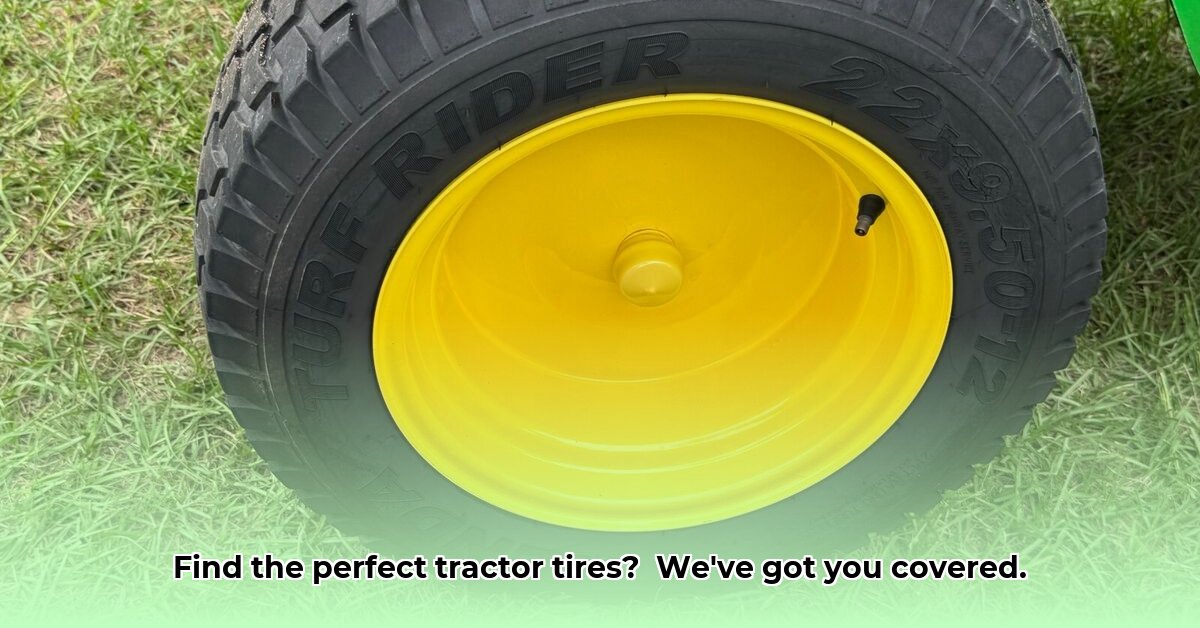
Choosing the right tires for your lawn tractor significantly impacts its performance, longevity, and your overall mowing experience. This comprehensive guide focuses on 22x9 50 12 tractor tires, covering everything from understanding tire specifications to installation, maintenance, and troubleshooting. For more detailed information on lawn tractor tires, check out this helpful resource: Lawn Tractor Tire Guide.
Decoding the 22x9 50 12 Tire Size: Understanding the Numbers
The seemingly cryptic "22x9 50 12" designation actually reveals crucial tire dimensions:
- 22: Overall diameter of the tire (including the rim) in inches. This is the total size from one side of the tire to the other, passing through the center.
- 9: Tire width in inches, measured at the widest point.
- 50: Aspect ratio; the tire's sidewall height is 50% of its width (4.5 inches in this case). This ratio indicates the tire's profile. A higher aspect ratio means a taller sidewall.
- 12: Rim diameter in inches. Your wheel must have a 12-inch diameter to accommodate this tire.
[Diagram of 22x9 50 12 tire with labels indicating diameter, width, aspect ratio, and rim diameter]
Understanding these dimensions is essential for ensuring a proper fit and optimal performance. Incorrect sizing can lead to handling issues and premature wear.
Types of Lawn Tractor Tires: Matching the Tire to Your Terrain
Different tire types cater to specific terrains and mowing needs. Here’s a comparison:
Turf Tires: Feature a smooth tread pattern, minimizing lawn damage. Ideal for manicured lawns, but offer less traction on uneven or wet surfaces.
Lug Tires: Aggressive, knobby treads provide superior traction on uneven terrain, hills, and in wet conditions. However, they can leave marks on delicate lawns.
All-Terrain Tires: A compromise between turf and lug tires, providing decent traction on a variety of surfaces. They may not excel in extreme conditions.
[Images of each tire type with examples of tread patterns]
Choosing the wrong tire type can negatively impact your tractor's performance and your lawn's health. Consider your terrain when making your selection. Do you frequently encounter hilly terrain, wet grass, or significant obstacles? This will influence your choice of tire significantly.
Key Factors to Consider: Budget, Terrain, Usage, and Sustainability
Selecting the perfect tires involves careful consideration of several key factors:
Budget: Tire prices vary considerably. While more expensive tires generally offer superior durability and performance, a cost-effective option might suffice for infrequent use. Higher-quality materials translate to longevity. What's your budget? What's your frequency of use?
Terrain: The type of terrain you mow dictates the appropriate tire type. Turf tires are ideal for smooth, even lawns, while lug tires are better suited for rougher, uneven terrain. Consider the composition of your soil, and the slopes involved.
Usage: Frequent, heavy use demands more robust and durable tires. For occasional use, a less expensive option might be sufficient, provided it still provides adequate performance. How frequently and for how long will you use the tractor?
Sustainability: As consumers become more environmentally conscious, we see manufacturers incorporating recycled materials into their products to reduce their environmental impact. Consider the tire's lifespan and proper disposal methods when making your decision. How important is reducing your environmental footprint?
Installing and Maintaining Your 22x9 50 12 Tires: A Step-by-Step Guide
Proper installation and maintenance are essential for optimal tire performance and longevity. Always consult your lawn tractor's owner's manual for specific instructions and safety precautions.
Installation:
- Preparation: Securely jack up your tractor and ensure it's stable. Improper jacking can pose a serious safety risk.
- Removal (if replacing): Loosen the lug nuts before lifting the tractor to facilitate easier removal of old tires.
- Mounting: Carefully mount the new tires onto the rims, ensuring they are seated correctly and evenly. Professional mounting services are available if needed.
- Inflation: Inflate the tires to the manufacturer's recommended pressure. Over-inflation reduces tire life; under-inflation impacts traction and control.
- Torque: Correctly torque the lug nuts to the manufacturer's specifications to avoid loosening or damage.
Maintenance:
- Regular Inspection: Regularly inspect your tires for punctures, cuts, or abnormal wear.
- Pressure Checks: Check tire pressure frequently, at least once a month and before every use. Ensure consistent pressure levels across all tires.
- Rotation: Rotate tires periodically (consult your manual for recommendations) to even out wear.
- Storage: Store unused tires in a cool, dry place away from direct sunlight and extreme temperatures.
Troubleshooting Common Problems: Addressing Potential Issues
Despite careful maintenance, problems can arise. Here's how to address some common issues:
- Punctures: Inspect tires regularly for punctures. Small punctures might be repairable with a patch kit, while larger ones usually require replacement.
- Uneven Wear: Uneven tire wear indicates issues with inflation, wheel alignment, or potential mechanical problems with the tractor. Addressing these promptly is crucial.
- Pressure Loss: Consistent pressure loss suggests a leak. Inspect the valve stems and tire sides for damage, and consider professional help if needed.
Conclusion: Making the Right Choice for Your Needs
Selecting the appropriate 22x9 50 12 tractor tires is critical for a smooth and efficient mowing experience. By considering your budget, terrain, usage patterns, and sustainability concerns, you can make an informed decision that optimizes performance and longevity. Remember that regular maintenance and prompt attention to issues will extend the life of your tires and ensure your lawn tractor continues to operate effectively for years to come.